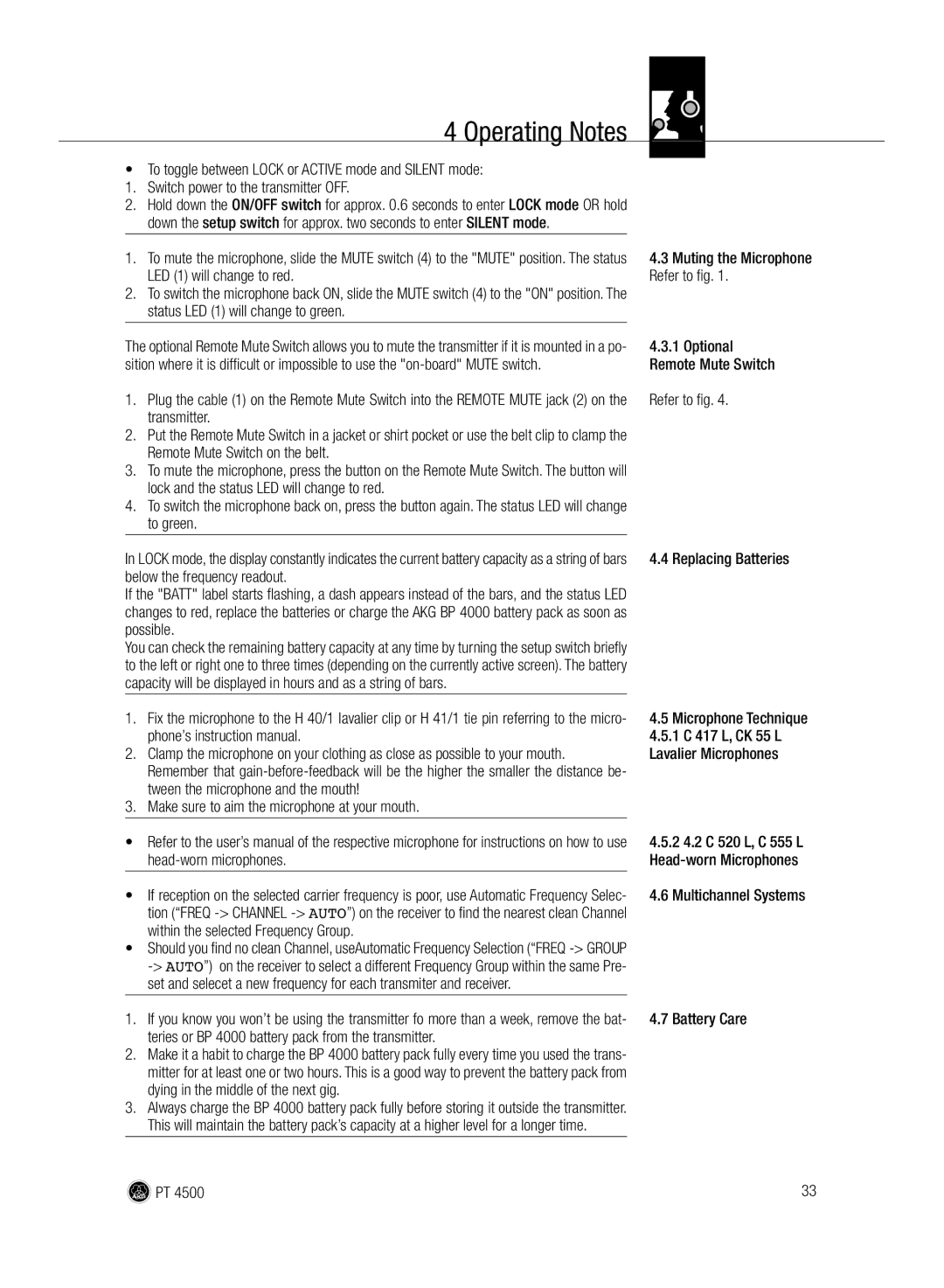
4 Operating Notes
• | To toggle between LOCK or ACTIVE mode and SILENT mode: |
| |
1. | Switch power to the transmitter OFF. |
| |
2. | Hold down the ON/OFF switch for approx. 0.6 seconds to enter LOCK mode OR hold |
| |
| down the setup switch for approx. two seconds to enter SILENT mode. |
|
|
1. | To mute the microphone, slide the MUTE switch (4) to the "MUTE" position. The status | 4.3 Muting the Microphone | |
| LED (1) will change to red. | Refer to fig. 1. | |
2.To switch the microphone back ON, slide the MUTE switch (4) to the "ON" position. The status LED (1) will change to green.
The optional Remote Mute Switch allows you to mute the transmitter if it is mounted in a po- | 4.3.1 Optional |
sition where it is difficult or impossible to use the | Remote Mute Switch |
1. Plug the cable (1) on the Remote Mute Switch into the REMOTE MUTE jack (2) on the | Refer to fig. 4. |
transmitter. |
|
2.Put the Remote Mute Switch in a jacket or shirt pocket or use the belt clip to clamp the Remote Mute Switch on the belt.
3.To mute the microphone, press the button on the Remote Mute Switch. The button will lock and the status LED will change to red.
4.To switch the microphone back on, press the button again. The status LED will change to green.
In LOCK mode, the display constantly indicates the current battery capacity as a string of bars | 4.4 Replacing Batteries | |
below the frequency readout. |
| |
If the "BATT" label starts flashing, a dash appears instead of the bars, and the status LED |
| |
changes to red, replace the batteries or charge the AKG BP 4000 battery pack as soon as |
| |
possible. |
| |
You can check the remaining battery capacity at any time by turning the setup switch briefly |
| |
to the left or right one to three times (depending on the currently active screen). The battery |
| |
capacity will be displayed in hours and as a string of bars. |
|
|
1.Fix the microphone to the H 40/1 lavalier clip or H 41/1 tie pin referring to the micro- phone’s instruction manual.
2.Clamp the microphone on your clothing as close as possible to your mouth. Remember that
3.Make sure to aim the microphone at your mouth.
4.5Microphone Technique 4.5.1 C 417 L, CK 55 L Lavalier Microphones
• | Refer to the user’s manual of the respective microphone for instructions on how to use | 4.5.2 4.2 C 520 L, C 555 L | |
|
|
|
|
• | If reception on the selected carrier frequency is poor, use Automatic Frequency Selec- | 4.6 Multichannel Systems | |
| tion (“FREQ |
| |
| within the selected Frequency Group. |
| |
•Should you find no clean Channel, useAutomatic Frequency Selection (“FREQ
1. If you know you won’t be using the transmitter fo more than a week, remove the bat- | 4.7 Battery Care |
teries or BP 4000 battery pack from the transmitter. |
|
2.Make it a habit to charge the BP 4000 battery pack fully every time you used the trans- mitter for at least one or two hours. This is a good way to prevent the battery pack from dying in the middle of the next gig.
3.Always charge the BP 4000 battery pack fully before storing it outside the transmitter. This will maintain the battery pack’s capacity at a higher level for a longer time.
PT 4500 | 33 |
